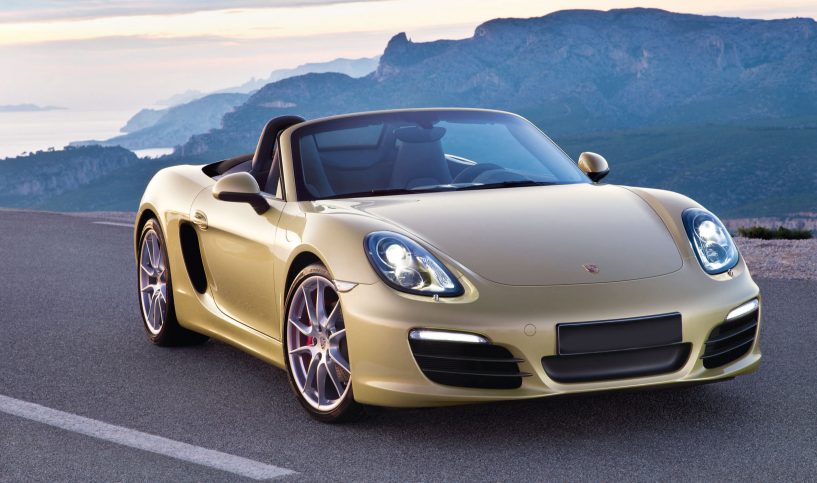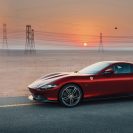When it comes to style on the road there can be little disagreement that Porsche have blazed a trail of luxury and speed all their own. Since the day the first 356 models hit the ground (actually before, given the fact that they got orders before building these) 90 odd years ago, this German manufacturer of long coveted luxury automobiles has been synonymous with speed and luxury. When the Boxter line was launched in 1996, it quickly became their biggest sellers ever.
What is most easily apparent when driving the Boxster is that it is a leaner, meaner machine. To sit in the driver’s seat is to feel like stepping into a cockpit; you don’t just sit in a seat, but rather pour yourself into an automotive hug. While it is normally referred to as mid-engine sports car, it is important to note that you can get more speed put into it should you so desire. Additionally, since it has two added power-up buttons, Sport and Sport Plus, you can literally upgrade your driving experience at the push of a button. Lighter and more fuel-efficient, faster and more agile–with an all-new lightweight design and completely revamped chassis, the latest generation of the Boxster is setting new top scores for Porsche Intelligent Performance.
This lower weight, when combined with a longer wheelbase, a wider track, and larger wheels, significantly enhance the mid-engine sports car’s driving dynamics. As an additional boost, they offer the Sport Chrono Package as an optional extra for the Boxster, featuring dynamic transmission mounts for the first time. Also new in this year’s model is Porsche Torque Vectoring (PTV) with mechanical rear axle differential lock.
The superior performance of the newer models is also enhanced by the fact that it is up to 15% more fuel-efficient than its predecessors. They boast ultra-modern, direct fuel injection, six-cylinder engines and all variants get by with less than nine liters of fuel per 100 kilometers, the Boxster with PDK even managing with less than eight liters.
Even for Porsche, the changes in this year’s model when compared to last are significant, and noticeable at first glance. For example, the wheelbase has increased by 60 millimeters and the front track width by up to 40 millimeters and at the rear by up to 18 millimeters, as a result of which the wheels align flush with the body. The windscreen is flatter and set approximately 100 millimeters further forward; all in all the Boxster is up to 13 millimeters lower. While this might not seem like much of a difference, consider what that feels like when you are turning a corner at high speed-you basically feel like you are locked into a track. Together with its convertible top line, which has been extended far to the back, the new Boxster cuts a very elegant silhouette. Another factor contributing to its sportier appearance is that the body is a mere 32 millimeters longer than before, while at the same time the overhang at the front has been reduced by 27 millimeters – if you like the compact roadster style, you are going to want to get one of these quick.
As for the design of the car itself, they additionally made several small changes that make for a big difference. For one, by moving the exterior mirrors up towards the vicinity of the upper edge of the door, there is a much sleeker look, as well as a better line of sight. The more distinctive shapes of the wings, doors, intake air guide and top further accentuate the wheel housing, though the layman may not notice it as much at first glance. The newly designed, larger alloy wheels further emphasize the car’s dynamics even when it is stationary. It comes with 18-inch wheels featured as standard; however, for the high-end enthusiast that wants to absolutely flaunt their way down the Gulf road on a Friday night, I recommend the even more imposing 19 or 20 inch wheels as optional extra—there’s nothing more sleek than a sports car pushing that wheel well full of chrome to capacity!
The new Boxster’s front-end is dominated by the large lateral radiator openings and the headlights. Both the halogen headlights, which come standard, and the new Bi-Xenon headlights (standard for the Boxster S) were completely redeveloped. The headlights, also redesigned, with daytime driving and position lights in LED technology, are integrated above the striking air intakes.
The rear end of the new Boxster models have been completely redesigned: there is no longer any convertible-top compartment lid: rear wing and lights are linked by a prominent edge spanning the entire vehicle width and the central lamp unit located beneath it combines the rear fog light and reversing lights in one flat strip. And it all happens at the push of a button to boot. The new taillights, all in LED technology, are perfectly integrated into the rear apron, with their shape curving around the corner of the car. The redesigned tailpipes complete the deep, centered look. This is further emphasized by the diffuser, which spans the width of the vehicle. A characteristic feature of the Boxster is an oval tailpipe; though the S model has a twin-flow double tailpipe.
To increase efficiency, the boxer engines feature electrical system recuperation and map controlled cooling water thermal management. In terms of electrical system recuperation, the battery receives an increased charge during the braking or coasting phases. Reducing the generator charging current with a full battery in turn reduces the load on the combustion engine during acceleration phases as the combustion engine does not have to sacrifice so much power for charging the battery. Thanks to the intelligently managed cooling systems shared by both engine and transmission, both of them reach their operating temperatures more quickly, meaning better combustion under partial load with less friction. To avoid any disadvantages under full load, the map-controlled thermostat – as required by the driver – very quickly reduces the temperature under full load even below the level of the predecessor model, thus ensuring an optimal charge and maximum performance. Moreover, Porsche is introducing the start/stop function for PDK and manual transmission in the Boxster as well.
The Boxster with PDK transmission is borrowing the principle of only drawing on engine power when it is actually needed from the new 911 Carrera- the call it coasting. What coasting means is rolling along without power, with the engine idling and with low fuel consumption to match. In practice, that means fuel savings of up to one liter per 100 kilo- meters with a forward-thinking driving style in everyday driving. Coasting is initiated by slowly taking one’s foot off the accelerator or by a manual upshift command if the highest possible gear given the driving situation already happens to be engaged. Coasting is ended by accelerating, braking or by manually changing gear. Coasting is better for fuel consumption because it enables the vehicle to harness its kinetic energy and convert it into forward motion.
The gearbox is critical to driving performance, comfort and fuel consumption values. A six- speed manual gearbox is fitted as standard in the new Boxster models, the gear ratios being optimally matched to the engine characteristics. You can further drive it as automatic, or as manual via paddle shifters on the steering wheel. If you want to feel like a real sports car driver, this is the way to go. And, because they use the smart engine system, they will drop the gear down for you automatically, so you don’t leave the engine on the street behind you should you not downshift until too late! All in all, the smart design and efficiency of these cars, combined with all the makings of an absolute monster of a luxury sports car, make this a ride you need to get out and drive today.
The Porsche Boxter is available from Behbehani Motors Company. Visit their showrooms in Shuwaikh and on the Fourth Ring Road. For more information visit www.behbehanimotors.com.








